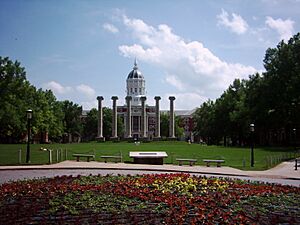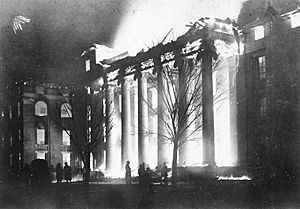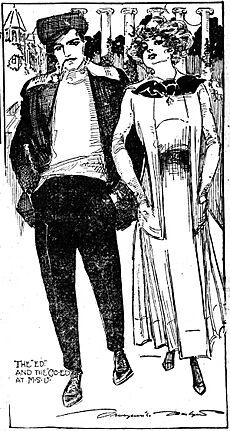History of the University of Missouri facts for kids
The University of Missouri in Columbia, Missouri, started in 1839. It later grew into the larger University of Missouri System that serves the whole state.
Contents
How Mizzou Began
The University of Missouri, often called MU or Mizzou, was created in 1839. It was the first public university west of the Mississippi River. People in Columbia and Boone County worked hard to bring the university to their area. They promised over $117,000 and land to win against five other counties. The land for the university was owned by James S. Rollins, who is known as the "father of the university."
Mizzou was the first university in the Louisiana Purchase area. Its design was partly inspired by Thomas Jefferson's ideas for the University of Virginia. Because of this, Jefferson's family even gave Mizzou his original tombstone in 1883.
In 1849, MU began teaching civil engineering, which was new for the western United States. The art department was named after the famous Missouri artist George Caleb Bingham. In 1867, the College of Education opened. It welcomed its first female students in 1868. By 1871, all parts of the university were open to women.
During the American Civil War, the university had to close for a while. Union soldiers used its main building, Academic Hall. The president's house became a place for Federal officers. The normal school, which later became the College of Education, was used as an army hospital. During this time, the people of Columbia were called the "fighting tigers." They fought hard to protect their city and the university from Confederate fighters. In 1890, a former student suggested calling the new football team the "Tigers" to honor these brave defenders.
Growing Stronger
A big change happened in 1870. The School of Agriculture and Mechanical Arts was created. This was thanks to the Morrill Land-Grant Acts. These acts gave colleges federal land to teach about farming and mechanical skills. The goal was to give practical education to working people. Missouri received land based on its number of senators and representatives.
There was a big discussion about where to put this new school. Some wanted a new school in Springfield, Missouri. But James S. Rollins helped keep the school in Columbia. At the same time, a branch campus was started in Rolla, Missouri. This was the Missouri School of Mines and Metallurgy. It focused on mining and reported to Columbia until 1964. That's when the University of Missouri System was formed.
In 1888, the Missouri Agricultural Experiment Station opened. This place helps with farming research. It grew to have ten centers and farms around Mid-Missouri. Soon, MU also added schools for law and medicine.
On January 9, 1892, a terrible fire destroyed Academic Hall. This was the university's main building. Some say the fire started because of the first electric light bulb west of the Mississippi River. The fire left only six stone columns standing. After the fire, some people wanted to move the university to Sedalia. But Columbia fought to keep it. As a thank you, Sedalia got to host the Missouri State Fair.
The six columns still stand today. They are a symbol of the campus. They are at the center of Francis Quadrangle, the oldest part of campus. Jesse Hall, built in 1895, is also in the quadrangle. It used to be called New Academic Hall. Today, Jesse Hall holds many university offices and Jesse Auditorium. The buildings around the quadrangle are made of red brick. This area is called "red campus." East of the quadrangle, many buildings were built in 1913 and 1914. They are made of white limestone and are known as "white campus."
The Early 1900s
In 1908, the world's first journalism school opened at Mizzou. It became famous for its "Missouri Method" of teaching. This method focuses on learning by doing. In 1911, MU held the first Homecoming event. It was at a football game against the University of Kansas. The University of Missouri School of Music started in 1917.
After World War II, many universities grew very fast. Mizzou was one of them. This was partly because of the G.I. Bill. This bill helped veterans pay for college. It was also around this time that the nickname "Mizzou" became popular. The name "Mizzou" likely came from a campus cheer. It's a shortened, friendly version of the university's old initials, MSU (Missouri State University). When said quickly, MSU sounds like Mizzou. Now, students and alumni use "Mizzou" and "MU" to talk about the university.
From Separation to Togetherness
In 1935, four students from Lincoln University wanted to join Mizzou's graduate school. Lincoln University was a school for Black students. Mizzou denied their admission. One student, Lloyd L. Gaines, took his case to the United States Supreme Court. In 1938, the court ordered Missouri to let Gaines into Mizzou's law school. Or, the state had to provide an equal law school for him. Sadly, Gaines disappeared in 1939. Mizzou later gave him an honorary law degree in 2006.
In 1950, a court ordered Mizzou to allow African American students into its undergraduate programs. This happened for courses that were not offered at Lincoln University.
Mizzou Today
In 1962, the University of Missouri became the "University of Missouri–Columbia." It is the main campus of the new University of Missouri System. Other campuses were added in Rolla, Kansas City, and St. Louis. Today, the Columbia campus is a leader in research. It has grown a lot in federally funded research over the last ten years.
Mizzou is part of the Southeastern Conference for sports. It is the only school in Missouri with all its sports in the NCAA Division I-A. This is the highest level of college sports. Mizzou has over 250,000 former students living all over the world.
In 1970, students were upset about events at Kent State University. They briefly took over the chancellor's office. Classes were canceled. Around this time, Peace Park was created near the journalism school. It is a special place for peace and remembrance.
In 1978, Barbara Uehling became Mizzou's third chancellor. She was the first woman to lead a major state university in the country.
In 2015, students shared concerns about racial issues. After these events, the chancellor and the president of the University of Missouri System stepped down.
Leaders of Mizzou
Each campus of the University of Missouri System has a leader called a chancellor. The chancellor reports to the president of the UM System. Before 1963, the Columbia campus was led directly by the president. The chancellor role did not exist then.
Presidents (1841–1966)
- John Hiram Lathrop (1841–1849, 1865–1866)
- James Shannon (1850–1856)
- William Wilson Hudson (1856–1859)
- Benjamin Blake Minor (1860–1862)
- Daniel Read (1866–1876)
- Samuel Spahr Laws (1876–1889)
- Richard Henry Jesse (1891–1908)
- Albert Ross Hill (1908–1921)
- John Carleton Jones (1922–1923)
- Stratton Brooks (1923–1930)
- Walter Williams (1931–1935)
- Frederick Middlebush (1935–1954)
- Elmer Ellis (1955–1963)
Chancellors (1963–present)
- John W. Schwada (1964–1970)
- Herbert W. Schooling (1971–1978)
- Barbara S. Uehling (1978–1987)
- Haskell Monroe (1987–1993)
- Charles Kiesler (1993–1996)
- Richard L. Wallace (1997–2004)
- Brady J. Deaton (2004–2013)
- R. Bowen Loftin (2013–2015)
- Alexander N. Cartwright (2017–2020)
- Mun Choi (2020–present)




